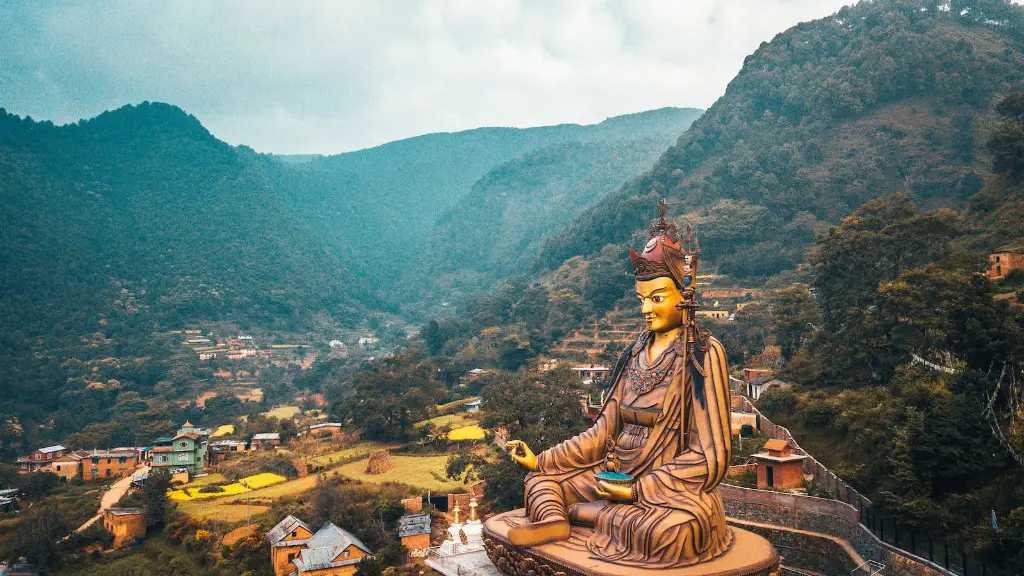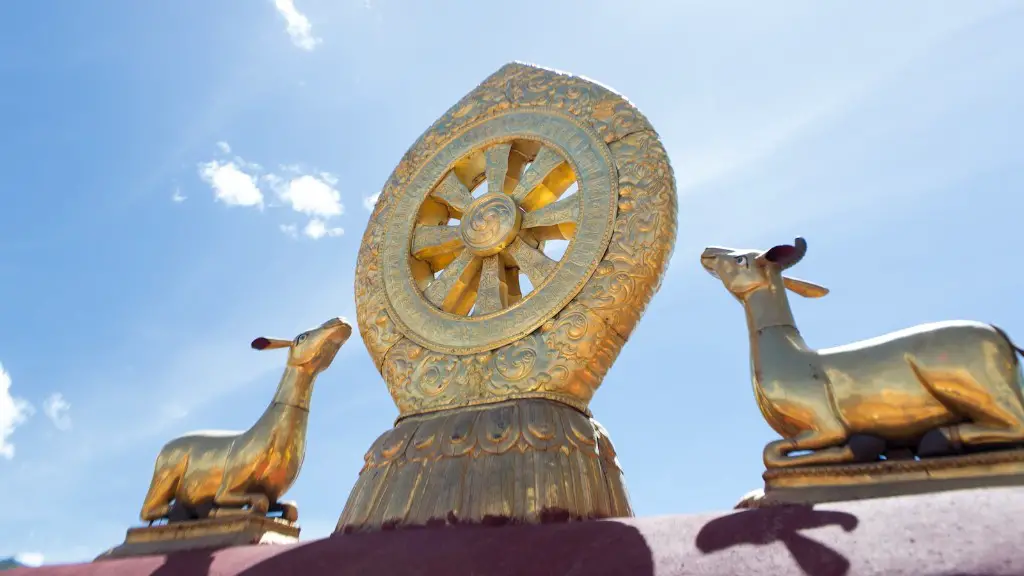The precise date of Ashoka’s death is unknown, but most historians believe that he died in 232 BCE. He was succeeded by his son, Kunala, who ruled for a short time before being succeeded by Ashoka’s grandson, Samprati. Ashoka’s last years were spent planning for the propagation of the Buddhist faith. He sent Buddhist missionaries to countries all over the world, including Sri Lanka, Egypt, Syria, Macedonia, and Greece.
He also built thousands of stupas and monasteries, and had numerous pillars and statues erected. In some cases, he even had his edicts inscribed on these pillars and statues. The most famous of these edicts is the Edict of Ashoka, which proclaims Ashoka’s respect for all religions and his commitment to peace.
By creating a large network of religious teachers and sending out missionaries, Ashoka helped to spread Buddhism throughout India and beyond. He also built numerous shrines and monuments, which helped to promote the religion. In addition, Ashoka’s policies of religious tolerance and support for the arts and education contributed to the popularity of Buddhism.
How was Buddhism spread?
Buddhism is a religion that began in India and quickly spread throughout Asia. The main reason for its spread was the development of the silk routes, which provided a means of communication and trade between different cultures. Buddhism was able to take advantage of this network to spread its message to new areas.
Sri Lanka is one of the countries where Buddhism was widely propagated and spread by Ashoka. There are many Buddhist monuments and elaborately carved cave temples found at Sarnath, Ajanta, Bodhgaya, and other places in India which date back to the reigns of Ashoka and his Buddhist successors.
How did Buddhism spread from India
Buddhism was spread outside India through the efforts of missionaries, scholars, trade, emigration, and communication networks. Foreign monks who travelled along the silk route between India and China were responsible for the spread of Buddhism at sub-elite levels. In addition, Indian monks and scholars travelled to China to teach Buddhism, and Chinese pilgrims travelled to India to learn about the religion. Trade also played a role in the spread of Buddhism, as merchants travelling between India and China brought Buddhist texts and artifacts with them. Finally, communication networks such as the Indian Ocean Maritime System allowed for the exchange of ideas and information between different cultures, which helped to spread Buddhism to new areas.
Buddhism became prominent in merchant communities and then spread throughout the Mauryan empire through commercial connections and along trade routes. In this way, Buddhism also spread through the silk route into central Asia.
Which event helped the spread of Buddhism?
Emperor Ashoka was one of the most influential rulers of ancient India. He ruled the Mauryan Empire from 268 to 232 BCE and used his power and conquests to spread Buddhism throughout India and beyond. He sent missionaries from his empire into the surrounding regions, including Central Asia, Southeast Asia and Sri Lanka. Ashoka’s legacy has had a lasting impact on all of these areas, and his story is an inspiring example of how one person can make a difference in the world.
Buddhism was founded by Siddhartha Gautama, also known as the Buddha, in the early 6th century BCE. The Buddha was born into a wealthy family in what is now Nepal. He grew up sheltered from the outside world and had little exposure to religion. At the age of 29, he left his family and home to search for answers to the suffering he saw all around him. After six years of study and meditation, he finally attained enlightenment and began teaching others what he had learned.
The Buddha’s teachings were simple and emphasised non-violence, the sanctity of nature and animal life. These values resonated with many people and the religion quickly spread throughout India and beyond. Buddhism had a profound impact on Indian culture and the way of life during the Maurya empire. It continues to be an important religion in India and around the world today.
Why did Buddhism spread so rapidly in India?
Buddhism grew quickly in popularity due to the simplicity of its teachings and the fact that it was taught in the common language of the people. The patronage of two great emperors – Ashoka and Kanishka – helped spread the religion to different parts of the world. Additionally, Buddhism’s opposition to the caste system made it popular among those who were considered to be of lower caste.
Buddhism is a religion that is based on the teachings of Siddhartha Gautama. It is one of the largest religions in the world, with over 500 million followers. Buddhism teaches that the way to end suffering is through the Four Noble Truths and the Eightfold Path.
Who brought Buddhism from India
Siddhartha Gautama, the founder of Buddhism, was born into a wealthy family as a prince in present-day Nepal. Gautama lived during the 5th century BC and later became known as “the Buddha.” The Buddha’s teachings focus on the Four Noble Truths, which are that suffering exists, that suffering has a cause, that suffering can be ended, and that there is a path to the end of suffering. The Buddha’s path to the end of suffering, known as the Eightfold Path, includes right understanding, right thought, right speech, right action, right livelihood, right effort, right mindfulness, and right meditation.
Buddhism is a religion and philosophy originating in India. The Buddha, Siddhartha Gautama, preached a Middle Way between sensual indulgence and the severe asceticism found in the Vedic tradition, which was the prevalent religion at the time. Buddhism teaches that one can escape the cycle of suffering and rebirth through ethical development and spiritual insight.
Buddhism slowly declined in India after the 12th century, due in large part to the rise of Hinduism and Islam. Hinduism absorbed many Buddhist practices and beliefs, while Islam discouraged the practice of Buddhism. In recent years, however, Buddhism has seen a resurgence in India.
Who were the first to spread Buddhism?
The first missionaries and translators of Buddhists scriptures into Chinese were either Parthian, Kushan, Sogdian or Kuchean. These people helped to spread Buddhism to different parts of Asia and introduced the religion to new cultures. They also played a key role in translating the scriptures into Chinese, which allowed for more people to access and understand the teachings of the Buddha.
In the 7th century, a Chinese monk named Xuanzang embarked on a 17-year journey to bring Buddhist teachings from India to China. Xuanzang subsequently became a main character in the great Chinese epic Journey to the West. The life and adventures of Xuanzang offer a fascinating glimpse into the religious and cultural exchange between India and China during the Tang dynasty.
Who was the first to promote Buddhism
Ashoka was one of the most influential rulers in Indian history. He is known for his promotion of Buddhism, as well as his laws encouraging people to do good deeds and practice nonviolence. Ashoka also had thousands of stupas built throughout India, which helped to spread the Buddhist religion. Although he was a devout Buddhist himself, Ashoka was tolerant of all beliefs and allowed his Hindu subjects to practice their own religion.
Buddhism is founded on the teachings of Siddhartha Gautama, who was born in the 6th century BCE in India. Siddhartha Gautama was a spiritual teacher and philosopher who shared his wisdom with others in order to help them find inner peace and happiness. The Buddha’s teachings have helped millions of people find meaning and purpose in their lives, and the religion continues to be an important force in Asia today.
How did Buddhism come to an end in India?
The Muslim invasion of India nearly wiped out Buddhism. From 712 AD onwards, their invasions of India became more frequent and recurrent. As a result of these invasions, Buddhist monks have sought refuge in Nepal and Tibet. In the end, Vajrayana Buddhism faded out in India, its birthplace.
Buddhism has had a remarkable impact on the political, social, religious, and cultural life of India. In social life, Buddhism contributed to egalitarianism by raising voice against caste discrimination and social oppression. It helped in the upliftment of women by making religion and education accessible to them. Buddhism also made a significant contribution to the religious and cultural life of India.
Conclusion
After the Battle of Kalinga, Emperor Ashoka made a vow to spread the Buddhist principles of ahimsa (non-violence) and dhamma (righteousness). He did this through a variety of means, including constructing stupas and pillars across his empire, sending out missionaries to spread the Dharma, and holding regular religious assemblies. Emperor Ashoka’s efforts helped to make Buddhism one of the most influential religions in the world.
In conclusion, Ashoka spread Buddhism through his policies of dhamma, religious tolerance, and his personal example. His Edicts of Ashoka record his efforts to promote Buddhist principles of Dharma and Sila throughout his empire, and he is credited with building many stupas and monasteries. He also sent missionaries to spread Buddhism to other countries, such as Sri Lanka and Greece. Finally, his personal example as a ruler who followed the Buddhist Dharma helped to inspire others to follow the religion.



